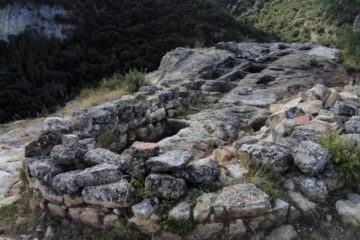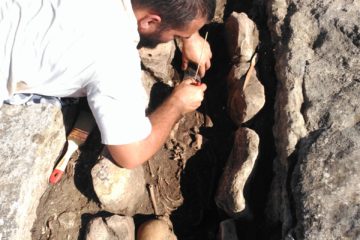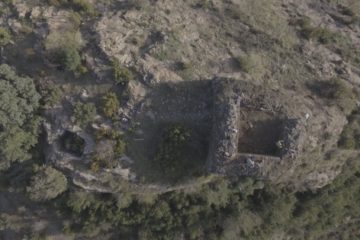Site: Sant Martí de les Tombetes (St. Esteve de la Sarga, Pallars Jussà).
Campaigns: 1998-2002 and 2013 to present.
Directors: Núria Nolasco, Conxi Rodríguez, Olga García (1998-2002), Walter Alegría (2013-2017), Izaskun Ambrosio (2017-2021), Marta Sancho, Isabel Hidalgo (2013-2015), Núria Artigas, Júlia Coso (2016), Pau Falcó (2019) and Júlia Coso (2020-2021).
Description:
It is located along the ridge that leads to the hill Lo Grauet, about 775m high, at one of the elevations that we find following the course of the meanders of the Barranc del Bosc. The western ridge is the most practicable and can be accessed through a path that leads to this end, protected by a wall dating from Roman times.
It is a rural settlement dating from the 4th century AD to the 13th century AD. The site stands out for having a necropolis, which covers all chronology, located around a church that was built after the foundation of the cemetery. It is a rather small necropolis in extension, but very important in terms of anthropological remains, since it sheltered many deceased for a long period of time and shows an evolution in terms of ritual, burial and tombs.
Roman, late-antique and medieval habitat and production structures have been identified on the southern and eastern ridges of the hill.
First phase (IV-VIII Century):
Second phase (IX-XIII Century):
Tombs after the construction of the church located around it. It differs from the first phase in the construction of the tombs, most were built and delimited with stones adapting to the terrain, although it is worth noting the presence of anthropomorphic tombs dug into the rock. The other fundamental difference is the absence of objects associated with the deceased, reflecting the equality between the inhabitants of Sant Martí de les Tombetes, as a consequence of the new Christian doctrine.
During the 2017 campaign, the area of the necropolis where, probably, children were buried was located and is in the process of study.
During the 2018 campaign, a construction from the Late Antique period was identified, which had a preparation of Opus Signinum as pavement. The presence of this element could be suggesting the presence of a space related to the liturgy or the cult of the foundation of the necropolis (4th-5th century) or a space of habitat of some important personage. For the moment, none of the above hypotheses can be ruled out until the excavation of this space is completed.








